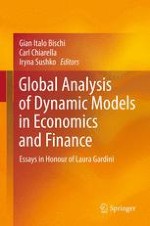2013 | OriginalPaper | Buchkapitel
Consistency of Linear Forecasts in a Nonlinear Stochastic Economy
verfasst von : Cars Hommes, Gerhard Sorger, Florian Wagener
Erschienen in: Global Analysis of Dynamic Models in Economics and Finance
Verlag: Springer Berlin Heidelberg
Aktivieren Sie unsere intelligente Suche, um passende Fachinhalte oder Patente zu finden.
Wählen Sie Textabschnitte aus um mit Künstlicher Intelligenz passenden Patente zu finden. powered by
Markieren Sie Textabschnitte, um KI-gestützt weitere passende Inhalte zu finden. powered by
